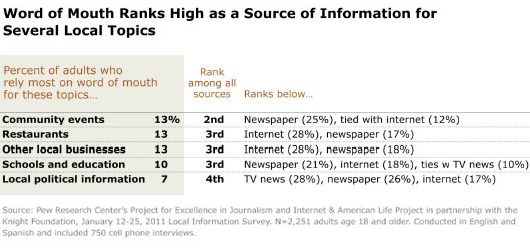Overview
In addition to the three biggest media platforms—newspapers, television and the internet—the local news and information ecosystem involves a complex mix of other sources as well. And for several local topics, citizen-based systems such as word of mouth (which does not include online social networking), print newsletters and bulletins, and the local government itself make appearances as sources that some residents rely upon. At the same time, the survey finds that radio emerges as a local news and information source of fairly limited recognition.
Word of mouth
“Word of mouth” through friends, family, neighbors and colleagues is a substantial source of community news and information. Overall, 55% of adults reported getting local news and information from this source at least weekly. And for 14 of the 16 local topics asked about, the survey found that word of mouth was the fourth most cited source or higher—usually ahead of radio.
For information about community events, such as parades or block parties, word of mouth was tied with the internet as the second most relied upon source. Just over half of all U.S. adults (57%) say they get information about community or neighborhood events. These adults most commonly cite local newspapers as their main source for information about this topic; one-quarter of all U.S. adults (25%) say local papers are the source they rely on most for this information. Yet another 13% say they hear about community events most often through word of mouth. Overall, word of mouth is cited as often as the internet (12%) as a key information source for community events, and is a particularly important source of information about community events for adults under age 40.
Among young adults, both word of mouth (17%) and the internet (19%) top local newspapers (13%) as a primary source of information about community events. Among adults age 40 and older, just 11% cite word of mouth and 9% cite the internet as their main source, while 32% say they rely on their local newspaper for this information.

Restaurants and local businesses are among the most followed local topics, with 55% and 60% of adults, respectively, reporting they get information about these topics. For information about both local restaurants and other local businesses, word of mouth is the third most popular source, in each case cited by 13% of adults as the source they rely on most. For each of these topics, word of mouth follows the internet and the local newspaper as the top two key sources, in order.
An equally high number of adults (58%) get information about their local schools, and for them, the local newspaper (21%) and the internet (18%) are the most commonly cited sources. Yet, one in ten adults cites word of mouth as the source they rely on most for this information, the same percent that cite local television news as their main source.
Word of mouth is also the fourth most-cited source for local politics, campaigns and elections, a topic about which two-thirds of adults (67%) report getting information. For 7% of adults, word of mouth is the source they rely on most for this information. This is driven mainly by adults age 40 and older, among whom 9% say this is their main source. Just 4% of younger adults say word of mouth is their top source for local political information, preferring the internet as a main source instead.
Radio
Radio is a key information source for the most time-sensitive local news and information topics. Just under half of adults (47%) report getting information about local traffic and transportation. Along with local television news, radio tops the list of sources for this information, reflecting the widespread use of radio by those commuting to and from work. While 19% of adults say that local television is their main source for traffic and transportation news and information, 15% cite the radio as their main source.
Roughly one in ten adults (9%) cite the radio as a key source for breaking news and weather. This makes radio the fourth most popular source for breaking news (behind, in order, television, newspaper and the internet) and it follows only television and the internet as a primary source for weather information. In addition, 5% of adults cite radio as a main source for both local political and arts and cultural information, while 4% rely on radio for crime updates.
Yet on a range of other topics, only 3% or fewer adults rely on radio as a source. Those low-registering topics are: local businesses (3%), community events (2%), taxes (2%), schools (2%), government activities (2%), social services (2%), restaurants (1%), housing and real estate (1%), zoning (1%), and local jobs (1%).
Print bulletins, newsletters and listservs
For the most part, print bulletins, newsletters and listservs are infrequently cited as a key source of local news. However, 7% of adults cite print bulletins and newsletters as their main source of information about both community events and local schools.
For community events, just as many adults rely on bulletins and newsletters as rely on local television news as their main source of information. Adults age 40 and older are slightly more reliant on print newsletters and bulletins for community event information than are younger adults, the latter preferring to learn about community events through the internet and word of mouth.
While local newspapers and the internet are far and away the most popular sources for information about local schools, cited by 21% and 18% of adults respectively, print bulletins and newsletters (preferred by 7% of adults) rival television (preferred by 10%) and word of mouth (also preferred by 10%).
The local government as information source
In contrast to citizen produced information such as newsletters, or commercially produced online information (not to mention professionally produced journalism), the efforts by local government to communicate directly to citizens barely registers as a key source of information for the majority of local topics included in the survey. Just 3% of adults say they rely on their local government (including both local government websites or visiting offices directly) as the main source of information for both taxes and for local social services, and even fewer cite their local government as a key source for other topics such as community events, zoning and development, and even local government activity.
Interestingly, in the case of local social services, non-internet users and older adults—populations generally more in need of such services—are more likely to rely on word of mouth as their key source of information about social services than to go directly to their local government. For both of these groups, local newspapers and television news are the top sources, but word of mouth is the third most cited source.




